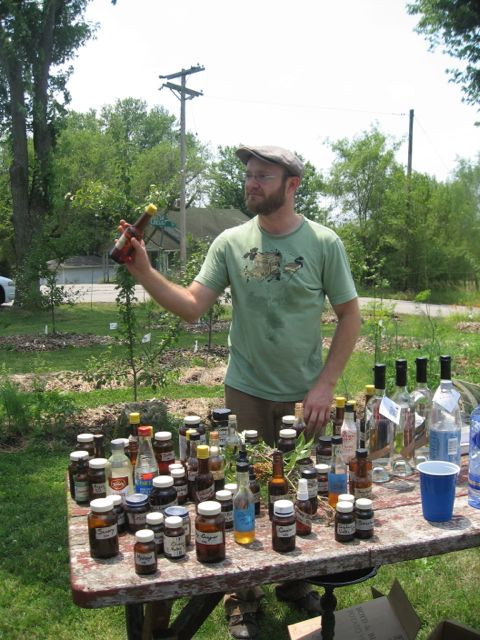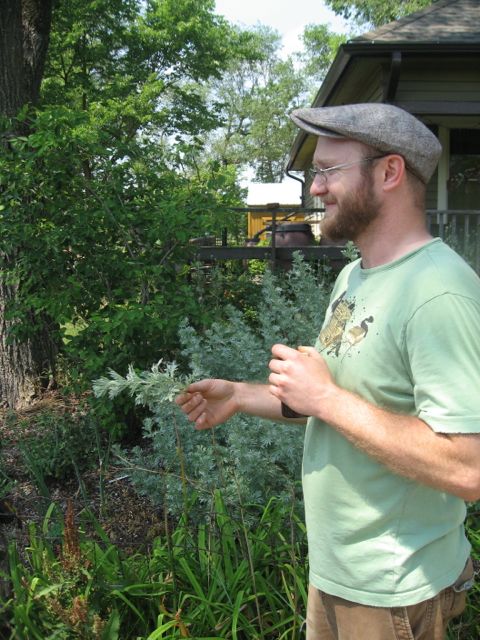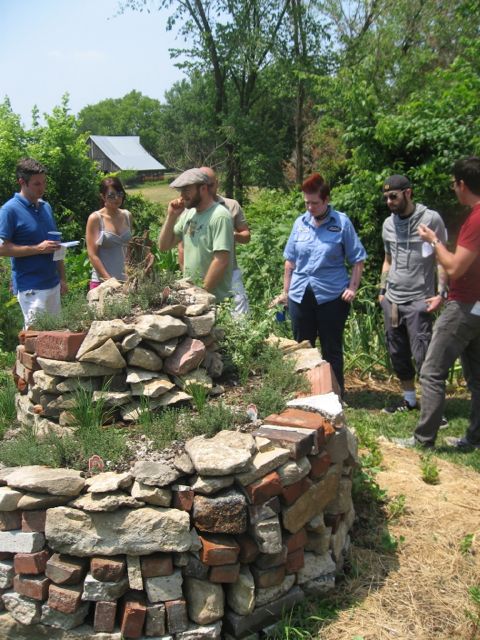There’s nothing new about bartenders using herbs. But no one does it quite like Chris Conatser of Justus Drugstore.
That’s why a handful of Kansas City’s bartenders—many of them members of the KC Bartenders’ Guild, a newly formed chapter of the U.S. Bartenders’ Guild—trekked up to Paradise, Mo., earlier this week for Conatser’s take on the herbal anatomy of a drink.

We met in the garden, which surrounds the home of Jonathan Justus and Camille Eklof, just down the road from their restaurant in Smithville, Mo. It’s an informal thing, with sinuous beds curving through what was once an empty, grassy lot and a scattering of raised stone-and-brick planters built by Justus.
Pretty enough, to be sure, but what grows here is clearly essential to the restaurant. Raspberries, lettuce, arugula (both wild and domestic), figs, cardoons (a wild artichoke variety), parsley, a native spice bush, lambs quarters, the rare-ish maple-leaf goosefoot, peaches… it all makes its way onto the plate and into the glass.
Conatser combines his fascination with plants (he’s a trained botanist who also regularly harvests wild plants; he’s moving to Portland, Ore., this autumn to study naturopathy) with his skill behind the bar to create liqueurs, bitters, tinctures and other concoctions with the same plants.

As innovative as it all seems, Conatser’s quick to point out what he does is nothing new. Folks have been flavoring alcohol with herbs for centuries, sometimes by adding them during distillation, other times by macerating or infusing them into alcohol, or by adding extracts.
It started as a medicinal practice—genever, gin’s granddaddy, was once considered good for you, Conatser says. We still drink it because it’s tasty. Still, recipes for many familiar brands remain secret, and they sometimes include so many ingredients that it’s hard to identify what’s what.
Which is why Conatser’s garden tour was so fascinating—as he talked about gin, Conatser handed around a juniper branch and jar of juniper berries and encouraged sniffing and sampling. Coriander? Conatser paused by the plant (called cilantro when the young leaves are used), and offered both fronds and seeds for tasting.
Bartenders nibbled their way around an herb spiral (just one of the dry stone raised beds built by Jonathan Justus) filled with nasturtiums, the celery-like lovage, borage with its pretty purple blooms, savory, hyssop, pineapple mint, French thyme and chives.

It’s not a large garden, but it’s layered with flavors whose potential Conatser clearly recognizes. He’s figured out how to bottle the fleeting aroma of blossoms, pull an almost amaretto-like flavor from peach leaves and turn candied trifoliate orange peels into one of the most intense and delightful orange bitters I’ve ever tasted—and use it all in compelling cocktails.
Conatser’s sometimes referred to as a mad scientist, thanks to his regular use of words like phenols, atom chains, integradation of chemicals. But there’s nothing madcap about his work at all. Standing in his garden, watching as he spritzes bartenders’ wrists with grape blossom bitters, it all seems quite natural.